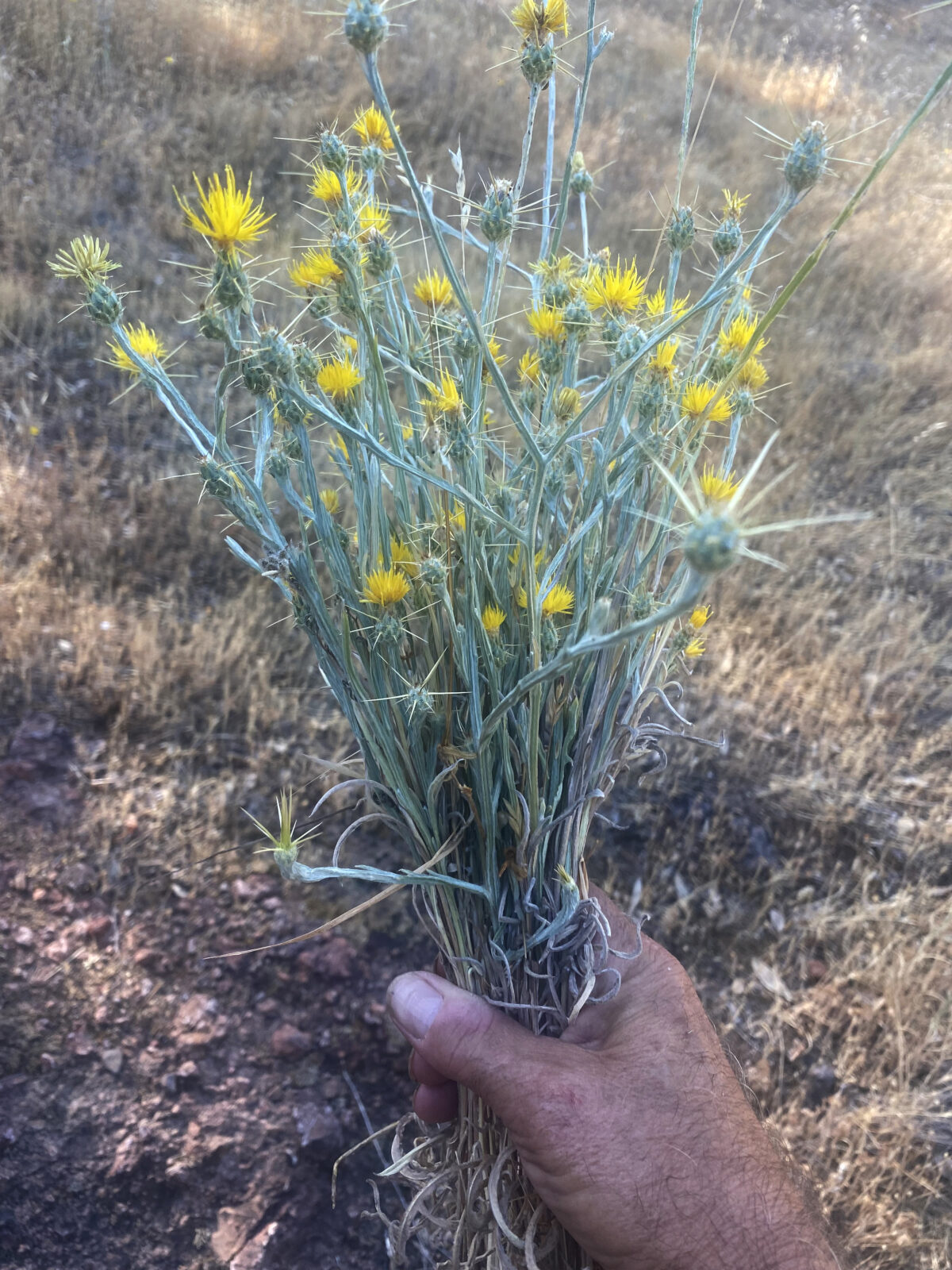“There is a great deal of satisfaction in wresting weeds out of the earth. Backbreaking and endless as the chore may be, there is a tiny but unassailable sense of triumph in it, feeling the soil give suddenly, yielding the stubborn root, and the foe lying defeated in your hand.”
— Diana Gabaldon, A Breath of Snow and Ashes
One June morning I stand up from my crouch, take my handkerchief from my back pocket, take off my hat, and wipe the sweat from my forehead. I look around. I’m in a meadow covered in yellow star-thistle (Centaurea solstitialis), an invasive plant that covers entire meadows across Northern California. I despair at the idea of pulling it all by hand, as there’s so much of it and I’m alone. That’s when the question that has saved me countless times since comes to me: “Did I make a difference today?” To which the answer is always “yes.”
I’ve done this work for over a decade, and in the last four to five years I’ve been out several days a week from November/December to July/August. I’ve essentially learned by doing, while consulting with staff at the Sonoma Ecology Center. What I’ve found is that doing this work requires being intelligently methodical—and absolutely relentless.

Here is some of what I’ve learned:
It’s not a battle, it’s a war of attrition. We can’t win, all we can hope to accomplish is to reduce the level of invasion to a manageable level. We may be successful in keeping a particular species off the properties completely, or away from trails, with due diligence over years, but we will never completely rid these properties of invasive species.
Don’t look up. Invasive species removal is a long game—something that takes concerted effort for many years to reach your goals. Think of saving for retirement: It takes work over a long period of time to achieve lasting goals. The point is that if you see the entire job before you, you may despair. But if you keep your head down and only look at what’s right in front of you, then you have a chance of going on, and really making a difference in the long term.
Look up. This is not a negation of the previous point, but sometimes it can really help to break out of your focus and enjoy where you are. Look off into the far distance, see the wildlife, feel the breeze, and drink it all in. If you’re enjoying yourself you’re more likely to keep doing the work.
Set achievable goals. When I first started pulling invasives, I had no goals. I just went out and did it. But when I took it on as a project, I discovered the need to set goals. Initially, in my ignorance, I set the goal of complete eradication. That was an unreasonable goal, it’s better to set a more modest goal of, for example, removing it from the trail edge. Once that’s achieved, another goal can be set. But don’t rush it, or you may become frustrated.
Know that one plant pulled today means ten you won’t have to pull next year, and a hundred the next. If one plant seeds another ten, and those each seed another ten the following year, very quickly you have exponential growth that quickly becomes uncontrollable. Knowing this can help manage discouragement.
Don’t start at zero tolerance. In serious infestations there is no way you can get it all at once. You may need to hit the same area half-a-dozen times or more. Only set an area to “zero tolerance”—where you pull everything you see—when the area warrants that designation. It may take several years to get to that point.
Use a variety of strategies, fit for purpose and timing. When I first began this work, I thought that pulling was the only strategy to use. But I realized that we could use a lot of different strategies, depending on the situation, the time of year, and other factors. Early in the season I begin with pull and toss, then move to pull and carry out when it starts to put on seed, and finally end up at weed whack. We’ve also experimented successfully with an application of 30 percent vinegar. There may be others still. The point is to be flexible, learn, and adjust as needed.
Know that there’s never just one. This is a rookie mistake—thinking that when you spot one invasive weed that’s all there is. This is almost never the case. As soon as you zoom in on that one weed, you will see others—perhaps many others.

Don’t let one patch get you down. When I first started I thought I needed to pull everything in a patch before moving away. But I quickly realized that for sanity I needed to take a break. Sometimes you just need to walk a bit and restart, and that’s fine. These days I only work until I feel like moving on, since I know I will be back tomorrow or the next day to fight it back farther.
Only do what you want to do. Otherwise you may never come back.
Use the seasons to your advantage. Invasive species have their own timetable, and some like Italian thistle come in early, while others like Yellow star-thistle, come in later. Meanwhile, you can get Scotch broom pretty much any time. Time your work appropriately.
You need to pull the big plants before you see the small ones. I’ve often been over the same ground multiple times, finding new plants each time. First, you pull the big plants, then you pull the small ones, then you pull the tiny ones you didn’t see before getting the others, or that came on later.
The idea of ridding even a small part of California free of invasive species seems like an impossible task, mostly because it is. But it’s still very much worth doing.
“Did I make a difference today?” Yes, yes I have. I hope to see you out there.




